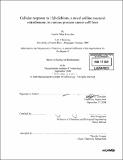Cellular response to 11[beta]-dichloro, a novel aniline mustard-estradienone, in various prostate cancer cell lines
Author(s)
González, Francis Héber
DownloadFull printable version (18.23Mb)
Other Contributors
Massachusetts Institute of Technology. Dept. of Chemistry.
Advisor
John Essigmann.
Terms of use
Metadata
Show full item recordAbstract
Cancer is a group of diseases characterized by uncontrolled cell growth and abnormal cell cycle and apoptosis regulation. Among the types of cancer, prostate cancer is the leading cause of death in men. Although many advances have been made in the last decade through anti-hormonal treatment, chemotherapy, and early screening, acquired chemotherapeutic resistance has presented a challenge to treating more advanced forms of prostate cancer. To meet this challenge a new compound, 11[beta]-dichloro, was designed that would integrate lessons learned from previous studies with other chemotherapuetics, specifically cisplatin. 11[beta]-dichloro is a novel aniline mustardestradienone that targets both DNA and the androgen receptor (AR), which is over expressed in many types of prostate cancer. The working hypothesis is that by causing substantial amount of un-repairable DNA damage and sequestering the transcription factor function of the androgen receptor it would result in a more effective treatment when compared to existing treatments. Hence, 11 [beta]-dichloro is expected to affect ARpositive prostate cancer cells more robustly than AR-negative cells, based on our repair shielding and transcription factor hijacking hypotheses. To assay differential toxicity, five different prostate cancer cell lines were used, namely, LNCaP (AR-positive, T887A), PC3 (AR-negative, p53 inactive), DU145 (AR-negative, p53 null), and the isogenic pair PC3-AR (AR-positive) and PC3-neo (AR-negative), which only differ in the AR status. Growth inhibition with LNCaP, PC3, and DU 145 cells showed that LNCaP cells are more sensitive to 11 [mu]-dichloro at concentrations higher than 5.0 tM. To better assay the effect of the AR in cell survival a clonogenic assay was developed using PC3-AR and PC3-neo cells. Preliminary growth inhibition studies with this isogenic pair showed differential toxicity towards AR-positive PC3-AR cells up to 10 [mu]M 11 [beta]-dichloro. (cont.) However, the series of clonogenic assay experiments showed no differential toxicity between these two cell lines. Nevertheless, these experiments are not conclusive because they were not carried out using a clonal population of cells. 11 [beta]-dichloro has been shown in previous studies to cause up regulation of certain proteins involved in cell cycle arrest and apoptosis regulation. By looking more closely at the effect of 11 [mu]-dichloro treatment on these proteins, potential biomarkers for the effectiveness of cancer treatment can be developed. In this work special attention will be given to p21, a cyclin-dependent kinase inhibitor that was significantly down regulated at early time points after treatment with 11 [beta]-dichloro, but which showed increased levels at later time points. Levels of p21 were assayed through Western blotting using the five different prostate cancer cell lines specified above after treatment with 10 [mu]M 11[beta]-dichloro up to 15 hours. LNCaP cells showed decreased levels of p21 throughout the time course, but more significantly from the 3-9-hour time points. DU145 cells showed increased levels p21 after just 3 hours of exposure with a subsequent decrease to untreated levels at the 15-hour time point. PC3 cells showed increased levels of p21 after 6 hours, with larger increases (6- and 7-fold) at the 9- and 15-hour time points. The isogenic pair PC3-AR and PC3-neo also showed a different expression profile for p21 expression with PC3-neo cells showing increased levels of p21 all through out the time course ranging from 1.8- to 2.5-fold increase. However, PC3-AR cells did not exhibit any p21 at any of the time points except for the 15-hour time point where a faint band could be appreciated. Although qualitatively these observations maybe accurate the quantitative aspect of the analysis will have to be reproduced more thoroughly as p21 levels were not normalized to actin expression for each sample. (cont.) Taken together these observations suggest that our candidate compound 11[beta]-dichloro exerts its effects on prostate cancer cells differently depending on the presence or absence of the androgen receptor and potentially p53 status. The model suggests that different mechanisms might be used in order to repair the DNA lesions caused by 11 [beta]-dichloro and that these mechanisms are dependent on the presence or absence of the AR since the AR can potentially block DNA repair proteins that are recruited to excise the lesion.
Description
Thesis (S.M.)--Massachusetts Institute of Technology, Dept. of Chemistry, 2009. In title on title page, "[beta]" appear as lower case Greek letter. Includes bibliographical references (leaves 35-36).
Date issued
2009Department
Massachusetts Institute of Technology. Department of ChemistryPublisher
Massachusetts Institute of Technology
Keywords
Chemistry.